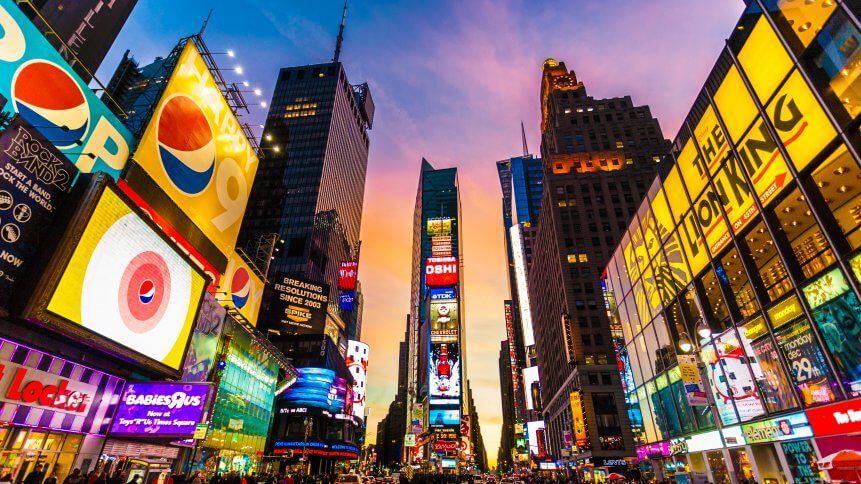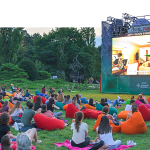The disruptive 5G future of DOOH advertising

Billboards are perhaps the most ubiquitous form of advertising.
Adorning every street corner, they are designed to catch the eye and stay buried somewhere within our minds. Their placement is strategic, targeting areas of heavy footfall, traffic, next to a train line or football stadium.
Attention is paid to local demographics— average income, house prices, political leanings— ensuring the advertiser’s message has the best chance of hitting its target audience.
Beginning as the humble flyer— a product of Johannes Gutenberg’s movable type printing in the 17th century, it was the Americans that thought “bigger was better”. Jared Bell’s first 50-square-foot ‘poster’ began by advertising a circus in New York, around 1835.
Big, bold and colorful, the Out of Home (OOH) advertising format grew to become symbols of our blooming 20th century consumerist societies, advertising toothpaste, cereals, cars, and sodas for those companies that could afford them. Their impact on brand awareness was such that blank space in the public eye-line has become a commodity; bus shelters, trains, taxis, malls, airport terminals walls— all are now blank canvases for marketers to plug their wares.
Unfazed by digital advertising
While the rise of digital advertising— and its ability to granularly target, measure and pay only for views or clicks— took the guesswork and risk out of advertising, billboards have remained a steadfast part of the marketer’s toolset, and have not been exempt from the digital revolution themselves.
In fact, as digital advertising falters owed mainly to brand safety and fraud concerns, ‘traditional’ forms of advertising are seeing a resurgence in popularity. There are now more than 8,800 Digital-Out-of-Home (DOOH) billboards in the US, according to Statista, while global expenditure is set to rise from US$6.7 billion in 2017 to US$15.6 billion in 2027.
This renewed interest is coupled with leading-edge innovation and technology within the DOOH industry. A long way from hand-painted beginnings, today’s LCD billboards can use video, location and weather data, even eye-tracking or movement recognition, to provide their audience with interactive, immersive and, crucially, memorable experiences.
British Airways’ award-winning ‘Magic’ billboard, for example, pointed out the location and flight number of real aircraft flying overhead. Women’s Aid’s ‘Look at Me’ billboard used facial recognition and geofenced push notifications to encourage passers-by to confront an image of a victim of domestic violence.
The largest creative canvas in history
In New York’s Times Square, the Mecca of dazzling blockbuster billboards, DOOH is an attraction in itself to some 450,000 people each day.
Here, a company called L&L Holding Company, together with Maefield Development and Fortress Investment Group is creating a building that will deliver 46 floors of experiential retail, entertainment, and accommodation – called TSX Broadway . The entire side of that building will be a digital billboard, in what David Orowitz, Managing Director of L&L Holding Company – the developer behind it – told TechHQ could “provide brands and creative agencies with what is arguably the largest creative canvas in history.
“Kids used to dream of coming to Times Square and looking at large signs and lights; now they can dream of engaging with the screens through their mobile devices and even be the ‘star’ in the ‘commercials’ on the big screen,” said Orowitz.
The 18,000 square-foot billboards will feature interactive features, such as selfie-cam for passers-by, who can also stream songs, engage with products and more from an app.
“Having dynamic real-time messaging on a screen as opposed to a static advertisement allows a brand to tell a full story instead of just presenting an image,” said Orowitz.
These functions give advertisers the ability to tap into their data to target ads further. Orowitz said it opens “a whole new world of possibilities in which consumers can interact with brands and products in the physical spaces.”
The tip of the building will also feature the first dynamic LED crown sign in New York, while a South-facing, high-definition LED screen can be seen down Broadway. The building’s exterior is essentially a shrine to DOOH.
YOU MIGHT LIKE

Best Western demonstrates power of AI in advertising
Stone age to the (5G) future
On the move to Digital-Out-of-Home, Andrew Essex, the ex-CEO of Droga5, Tribeca Film Festival, and now Founder of elite creative holding company Plan A, told TechHQ billboard advertising has transitioned from the “stone age to the future”.
“DOOH advertising allows messages to be addressable and measurable, which is a total game-changer.
“For the messages themselves, DOOH allowed advertising to be far more agile and location-specific and much nimbler, which allows for everything from better creative to more useful messages to become more possible.”
The possibilities for real-time optimization and interactivity will be furthered by the advent of 5G, enabling near-instant data transfer and connectivity, as well as developments in artificial intelligence.
“Interactive and self-aware signage will allow for much ‘smarter’ advertising, which will be connected to everything from location to mood and need-state,” said Essex.
“This will make for much less annoying advertising that ideally adds far more value to people’s lives. Cool DOOH companies like Lightbox are deploying this technology in retail environments and helping to drive business in new and unexpected ways.”
On how creative agencies will look to innovate and leverage new formats available, Orowitz said it will the real innovation will lie not in repurposing legacy content, but in “pushing the envelope creatively”.
“In 2022, they’ll be tasked with tapping into another level of creativity to match the scale and technological capabilities of digital billboards like TSX Broadway. It will house technology still being developed today and create a nimble blank slate that can be adaptable for tomorrow— a 3D canvas for the 5G future,” said Orowitz.
“When working on such revolutionary projects, it’s important to think about what seems impossible now, and realize that these project to bring those ‘pie in the sky’ ideas to life.”
Blade Runner’s 2049’s “You look lonely” scene is one example of how interactive and engaging billboards could come to life thanks to 5G and AR capabilities entering into DOOH advertising in the coming years.
According to Essex, the future of outdoor advertising will be all about “the convergence of speed, date, location and creative solutions that add value to people’s lives.
“The mind boggles at what will happen when images literally pop off the screen and ideas move at the speed of light.”








